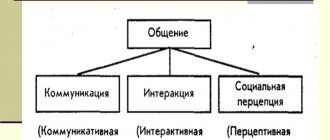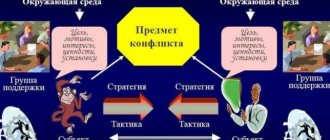What is conflict
Conflict is a disagreement or clash between people or groups of people that is caused by differences in goals, behavior or attitudes. The interests of the parties to the conflict do not coincide, while each side tries to ensure that its point of view is accepted, and the enemy insists on his position. Conflict, as a rule, is accompanied by negative emotions and is the most acute form of clarification of relationships.
It often happens that the result of conflict is actions that go beyond generally accepted rules and social norms. There is a whole science that studies conflicts. It's called conflictology.
Not only people are capable of sorting out relationships. In nature, collisions also occur between individuals and groups of animals. This indicates that conflicts play an important role in the interaction of all living creatures on the planet.
Causes of the conflict
Among the main causes of conflict, the following are usually identified:
• Resource allocation. As a rule, in any environment the number of resources is limited. At the same time, each individual tends to want to take possession of as many valuable assets as possible. On this basis, clashes arise, since both sides of the conflict want to increase their share of resources at the expense of each other.
• Task interdependence. In any organization there are interdependent elements - people, groups of people or departments. They are all united by one task, but to achieve it, each has their own roles. When someone does their role poorly, disagreements arise that can lead to conflict. In this case, the parties to the conflict are those people or groups of people who, on the way to accomplishing their task, encounter any obstacles caused by the actions of other elements.
• Differences in goals. It often happens that the goals that people or a group of people set for themselves differ from the goals of another department or the organization as a whole. In this case, during the practical implementation of the overall goal of the organization, conflict situations may arise.
• Differences in life experiences and values. People who differ in level of education, age, ideas about life and their habits may periodically conflict with each other.
Structure of the conflict. Conflict and incident.
Structure of the conflict
Basic structural elements of the conflict
Parties to a conflict are subjects of social interaction who are in a state of conflict or who explicitly or implicitly support those in conflict.
The subject of the conflict is what causes the conflict.
The image of a conflict situation is a reflection of the subject of the conflict in the minds of the subjects of conflict interaction.
Motives of conflict are internal driving forces that push subjects of social interaction towards conflict (motives appear in the form of needs, interests, goals, ideals, beliefs).
The main elements of conflict interaction are:
1) the object of the conflict;
2) subjects (participants) of the conflict;
3) social environment, conflict conditions;
4) subjective perception of the conflict and its personal elements.
By their nature and nature, all elements of conflict can be divided into two types: 1) objective (impersonal) and 2) personal.
The objective elements of a conflict include those components that do not depend on the will and consciousness of a person, on his personal qualities (psychological, moral, value orientations, etc.). Such elements are: the object of the conflict, the participants in the conflict, the environment of the conflict.
Personal elements of conflict include psychophysiological, psychological, ethical and behavioral properties of an individual, which influence the emergence and development of a conflict situation.
A person's character traits, habits, feelings, will, interests and motives - all this and many other qualities play a huge role in the dynamics of any conflict. But to the greatest extent their influence is found at the micro level, in interpersonal conflict and in conflict within the organization.
Among the personal elements of conflict, first of all, the following should be mentioned:
1) the main psychological dominants of behavior;
2) character traits and personality types;
3) personality attitudes that form the ideal type of individuality;
4) inadequate assessments and perceptions;
5) manners of behavior;
6) ethical values.
Differences in the named characteristics of people, their discrepancy and opposite nature can serve as the basis for conflict.
The positions of the conflicting parties are what they declare to each other during the conflict or in the negotiation process.
Conflict = participants + object + conflict situation + incident, where participants are subjects directly involved in all phases of the conflict, irreconcilably assessing the essence and course of the same events related to the activities of the other party;
an object is an object, phenomenon, event, problem, goal, action that gives rise to a conflict situation and conflicts;
a conflict situation is a situation of hidden or open confrontation between two or several participants (parties), each of whom has their own goals and motives, means and ways of solving a personally significant problem;
An incident is the practical actions of participants in a conflict situation, which are characterized by uncompromising actions and aimed at mandatory mastery of the object of heightened counter-interest.
Incident
The transition of a conflict from a latent state to open confrontation occurs as a result of one or another incident (from the Latin incidens - an incident that happens). An incident is one that initiates open confrontation between the parties. The incident of conflict cannot be distinguished from its cause.
An occasion is that specific event that serves as an impetus, a subject for the beginning of conflict actions. Moreover, it may arise by chance, or it may be specially invented, but in any case, the reason is not yet a conflict. In contrast, an incident is already a conflict, its beginning.
For example, the Sarajevo Murder - the murder of the heir to the Austro-Hungarian throne, Franz Ferdinand, and his wife, carried out on June 28, 1914 (new style) in the city of Sarajevo, was used by Austria-Hungary as a pretext for starting the First World War. Already on July 15, 1914, Austria-Hungary, under direct pressure from Germany, declared war on Serbia. And Germany’s direct invasion of Poland on September 1, 1939 is no longer a reason, but an incident indicating the beginning of World War II.
The incident exposes the positions of the parties and makes clear the division into “us” and “strangers”, friends and enemies, allies and opponents. After the incident, “who is who” becomes clear, because the masks have already been dropped. However, the real strengths of the opponents are not yet fully known and it is unclear how far one or another participant in the conflict can go in the confrontation. And this uncertainty of the true forces and resources (material, physical, financial, mental, information, etc.) of the enemy is a very important factor in restraining the development of the conflict at its initial stage. At the same time, this uncertainty contributes to the further development of the conflict. Because it is clear that if both sides had a clear understanding of the enemy’s potential and resources, then many conflicts would be stopped from the very beginning. The weaker side would not, in many cases, aggravate the useless confrontation, and the stronger side, without hesitation, would suppress the enemy with its power. In both cases, the incident would have been resolved fairly quickly.
Thus, an incident often creates an ambivalent situation in the attitudes and actions of opponents of the conflict. On the one hand, you want to quickly “get into a fight” and win, but on the other hand, it is difficult to enter the water “without knowing the ford.”
Therefore, important elements of the development of the conflict at this stage are: “reconnaissance”, collecting information about the true capabilities and intentions of opponents, searching for allies and attracting additional forces to one’s side. Since the confrontation in the incident is local in nature, the full potential of the parties to the conflict has not yet been demonstrated. Although all forces are already beginning to be brought into combat mode.
However, even after the incident, it remains possible to resolve the conflict peacefully, through negotiations, to reach a compromise between the parties to the conflict. And this opportunity should be used to the fullest.
If after the incident it was not possible to find a compromise and prevent further development of the conflict, then the first incident is followed by a second, third, etc. The conflict enters the next stage - it escalates (increases).
Classification of conflicts
If we take the main causes of conflicts and combine them, we can obtain a classification of the disagreements that arise. For example, if we consider conflicts of interest from the perspective of the party to the conflict, this assumes the following classification:
• conflicts between individuals;
• between a specific person and a group of people;
• among groups;
• between social communities;
• between ethnic groups;
• interstate conflicts.
Social conflicts based on motivation can also be distinguished. There are three blocks in total:
• conflicts related to the distribution of positions of power and authority;
• conflicts of interests based on the distribution of material resources;
• disagreements related to differences in basic life attitudes.
Classification of conflicts is a method of determining them, which consists in establishing a common characteristic by which conflicts can be grouped. At the same time, the parties to a social conflict interact with each other in a certain direction, characteristic of one or another form of opposition, which is determined by the reasons for the disagreement.
Key aspects of political conflicts
Based on these fundamental concepts that describe the essence of political conflicts, a number of their key aspects :
- a collision in the political sphere of 2 or more subjects, as well as communications between them;
- the main prerequisite for the clash between political subjects is considered to be power (seizure, retention, use of state power to achieve one’s own goals);
- the subjective reason for intensifying political confrontation is the understanding by political subjects of existing contradictions, their incompatibility and the impracticability of resolution by other methods;
- confrontation is the reason for the active actions of political subjects, which are aimed at confrontation (at the same time, the unilateral activity of one subject cannot be called a political conflict: an example would be the destruction of a rival, the seizure of a state, the enslavement of a people, etc.);
- political conflict is the most common method of resolving accumulated socio-political deep contradictions.
Based on the above, we can offer a comprehensive definition of the term. A political conflict is a confrontation between two or more opposing political subjects, the main reasons for which are considered to be incompatible socio-political ideals, interests, traditions, values, ideologies and goals, directly or indirectly related to power in the state.
Social functions of conflict
The social functions of conflict can be both positive and negative. The impact of conflict depends largely on the social system. In those groups that are freely structured, where conflict is the norm, and at the same time effective mechanisms for its resolution have been developed, contradictions contribute to increased resilience, dynamics and progress. If a social group has a totalitarian organization, where conflict is not allowed and is suppressed only by one method - force, then the conflict leads to disintegration and dysfunction. When unresolved differences accumulate, they lead to serious social problems.
Can behavior patterns in conflict change?
A conflict is always a clash of interests of two parties. What type of interaction participants choose depends on each person's behavior pattern. These models may differ in different situations. Everything depends on the status and personal qualities of the opponent, on his behavior pattern, on the choice of his strategy, on the conditions in which the conflict flares up, and on other external circumstances.
It is also important what kind of relationship the subjects of the conflict have, what connects them and how much they respect each other’s interests, how important it is for them to maintain friendly relations.
What the outcome of the conflict will be depends on both participants. Will it be resolved, or will it subside for some time, or perhaps even go into the stage of exacerbation.
When the conflict escalates, a change in the behavior pattern of one or both participants is possible. They may change places, become coercive, or become aggressive. In this case, the conflict will not be resolved; only external circumstances or third parties can interrupt it. In this case, even a temporarily ended conflict can arise again, since it was not resolved initially.
To prevent this from happening, it is important to control your emotions and not act destructively. If your opponent is aggressive and tries to force you to accept his point of view, then you need to end the conflict without continuing to explain and prove something. Walking away from a conflict does not mean giving in; you can remain with your point of view. Sometimes this is the best strategy to stay safe and “keep in face” without being provoked.
Positive aspects of the conflict
Confrontation is an integral source of the development of society and the changes occurring in it. When developed correctly, conflict has positive results. These include:
• Progressive changes. Any new beginning involves the negation of the old. This is a kind of conflict between established foundations and new trends. Since there is a human factor behind any action, confrontation between adherents of the old and the new is inevitable.
• Mobilization of resources and attention. The positive aspects of the conflict in this case are manifested in the fact that it provokes people to take actions that are necessary to resolve any uncomfortable situation. It is possible for a long time, due to mutual respect, reluctance to provoke scandals, and other things, to avoid difficult issues. But when a conflict arises, problems have to be solved, mobilizing all the necessary resources and means for this.
• Involving the population in pressing issues. Conflict attracts society's attention to complex issues, and this, in turn, provokes people to take actions that help resolve the negative situation.
• Development of free thinking. Conflict, as a rule, aggravates the situation and helps eliminate the “submission syndrome.” The positions of the parties to the conflict are defended by its participants with great zeal, awakening in a person all his hidden resources.
Rivalry
Rivalry is a type of behavior when a subject strives to satisfy his own interests, causing damage to the interests of the opposing subject. Following the presented strategy, a person is confident that only one participant can gain the upper hand in a conflict, and victory for one will always mean defeat for the other. A person who prefers competition will “push his line” in every way available to him.
The opposite position will not be taken into account by them.
Basic human actions with the “Competition” strategy
- Tight control over your opponent's actions
- Constant and deliberate pressure on an opponent by any means
- The use of deception and tricks to create an advantage in one’s favor
- Provoking your opponent to make mistakes and ill-considered steps
- Reluctance to engage in constructive dialogue due to overconfidence
Pros and cons of the “Rivalry” strategy
Rigidly defending one's position can, of course, help the subject gain the upper hand in the event of a conflict. But such a strategy cannot be applied if the subsequent interaction of people involves long-term relationships, for example, joint work, friendship, love. After all, relationships can develop and generally have the right to exist only if the desires and interests of all people are taken into account, and the defeat of one will mean defeat for everyone. Therefore, if the person with whom you have a conflict is dear to you or the relationship with him is important to you for some reason, it is better not to use the strategy of competition to resolve the conflict.
2
Negative sides of the conflict
The negative sides of the conflict are dysfunctional phenomena that lead to a decrease in the efficiency of the organization. If we consider in more detail the negative aspects of the contradictions, among them we can highlight the following:
• Distracting people from real problems and goals. It often happens that the goal of defeating the enemy overshadows reasonable arguments, and selfish interests begin to prevail. In this case, the conflict does not solve pressing problems, but only distracts attention from them.
• Increased dissatisfaction, depression, mistrust of others and management. These phenomena reduce labor efficiency and do not contribute to unlocking people's potential.
• Fruitless waste of strength, energy and resources on internal struggle. In conflict situations, people spend certain resources, and when these costs do not help improve the unfavorable situation, this causes unjustified losses of resources that could be used in a more necessary direction.
functional consequences of conflicts for the organization:
1
The problem is solved in a way that suits all parties, and as a result, people feel involved in solving a problem that is important to them
2. A jointly and voluntarily made decision is implemented faster and better.
3. The parties gain experience in cooperation in resolving controversial issues and can use it in the future.
4. Effective resolution of conflicts between a manager and subordinates destroys the so-called “submission syndrome” - the fear of openly expressing one’s opinion that differs from the opinion of one’s seniors.
5. Relationships between people improve.
6. People stop viewing the presence of disagreements as an “evil” that always leads to bad consequences.
(-) interferes with the assertion of one’s own opinion and independent behavior.
Characters of the conflict
In any conflict, the following actors are distinguished:
A conflict participant is a person or group of people who are involved in a conflict situation. The participant may not even be aware of the true goals and objectives of the confrontation.
The direct participant in the conflict is the instigator. It is he who initiates the showdown.
The subject of the conflict is a person or group of people who creates an opposing situation. The subject is able to sufficiently influence the course of the conflict, focusing on his interests. The subject also influences the behavior and position of the participants in the conflict, involves new subjects in it and is capable of causing changes in social relations.
The parties to the conflict are new unities that are capable of acting as an independent whole. The parties to the conflict include only those social entities that take active actions towards each other. The parties to the conflict are unities that are formed around newly emerging issues from the remnants of old, disintegrated groups.
“Victim” in the structure of the opposing side
As a probable element in the structure of each of the opposing sides there is a “ victim ”. This victim can occur due to a number of reasons :
- as a result of the development of the conflict and the actions of the opposing parties;
- as an occasion or reason for the start of a political conflict.
Most often, in political science, “victim” refers to people and entire countries affected by conflict steps that are not directly involved in the conflict itself.
Conflict resolution
Any conflict situation is sooner or later resolved or frozen. In order to eliminate contradictions and constructively resolve the issue, it is necessary to recognize the existence of the conflict and identify its main participants. Then it is worth organizing a negotiation procedure, discussing pressing issues, searching for compromise solutions and putting the adopted resolutions into practice.
If it is possible to achieve such results, the conflict can be considered a positive phenomenon that has positive consequences.









